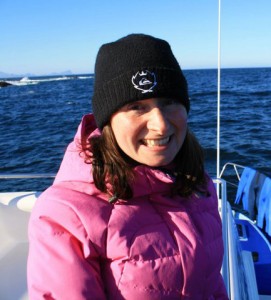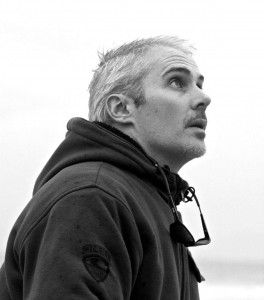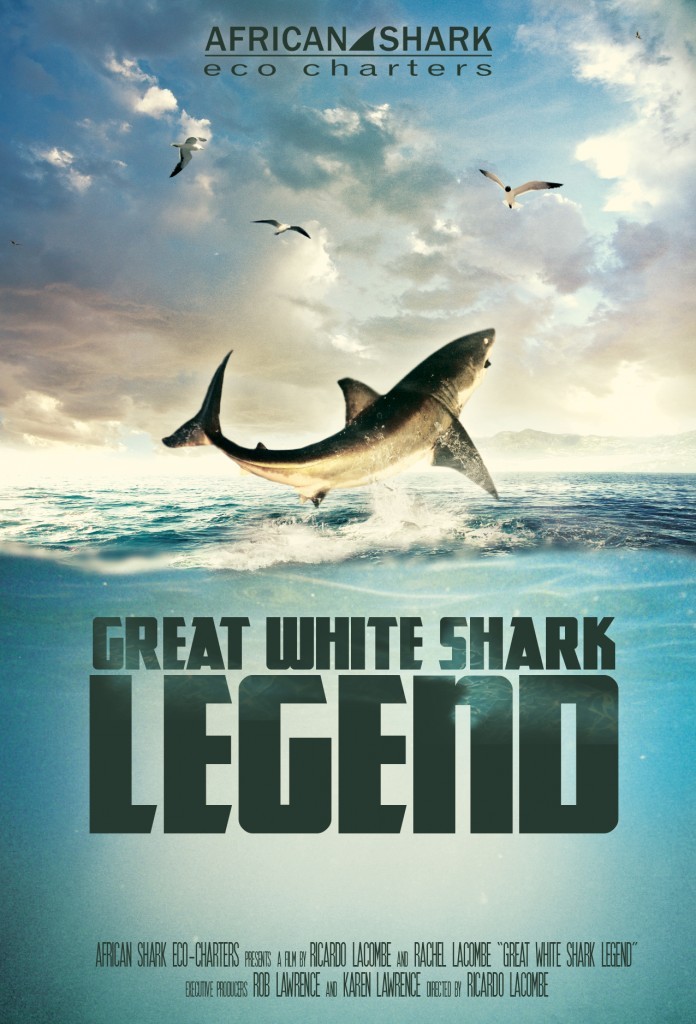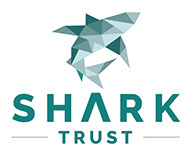Marine Life & Conservation
Great White Shark Legend: The Interview, Part 1

Jeff Goodman interviews Ricardo and Rachel Lacombe about their film, Great White Shark Legend
Great White Shark Legend is a well thought out and developed film. It is sensitively filmed and directed as well as being very informative and revelatory in both hard facts as well as emotional content. I talked with Ricardo and Rachel Lacombe about its making.

Rachel Lacombe

Ricardo Lacombe
 Jeff: Hi Ricardo and Rachel, congratulations on your excellent film about the Great White Shark.
Jeff: Hi Ricardo and Rachel, congratulations on your excellent film about the Great White Shark.
Ricardo: Thank you so much Jeff. It’s one of those projects that as a film maker you are definitely privileged to have made and even more privileged to have people take the time out to watch it.
Rachel: Thanks – we enjoyed making it! We always felt it was a story that needed telling and it’s always nice to hear from dive and shark enthusiasts.
Jeff: Is this your first film?
Ricardo: No no, not at all. I have been working as a film maker since 2007 where I kind of fell into it by chance. It was only after having made my first film for the pure fun of it, on very basic equipment, that I was given a broadcast option… on my first film! It was a very quick prompt for me and a colleague to invest in equipment and seek some real commissions and funding. We got our first gig 12 months after starting and have never looked back. I usually do corporate work, including the likes of Apple and British Airways, as well as having worked for Paramount Comedy Channel, Channel 4 in the UK, Sky TV, all as freelance. This then funds the passion projects which it’s hard to get funding for, and occasionally the passion and the paid work line up, which is what happened with Great White Shark Legend.
Rachel: Ricardo was already making films when I met him, corporate and independent. Over the years I gradually started getting involved and helping out and he started to realise I had an eye for camera work. I dived in a little when he was making a live DVD for a band with some cutaway camera footage he asked me to shoot. He used so much of it that he started asking me to take a bigger role in the next productions and we’ve worked on topics as varied as terminal illness, parenting, music videos and a no-holds-barred look at racism. This film however was our first venture into wildlife film making.
Jeff: What made you decide to do this? Had you dived with sharks before?
Rachel: It originally came from travelling out to see Great Whites for a holiday in 2011. Not long after we met we were planning a holiday and we asked each other what was the one thing the other wanted to do and we both said diving with Great Whites! We had no idea that the experience would be so different from the expectation and what we imagined. We thought it would be terrifying, we didn’t know if we would come back in one piece. Instead, we had the privilege of these majestic creatures behaving calmly and inquisitively in their own environment… that’s why we felt there was a story here that hadn’t been done on film before really…. how it really is being alongside these amazing animals and how even the most non-sensationalist TV shows still had an undertone of the Jaws mentality. It’s like they don’t know how to get away from it.
Ricardo: During that 2011 holiday I naturally took along some camera equipment and put together a very short piece for the fun of it – a professional home video if you like. I sent it to African Shark Eco-Charters (ASEC) for them to use if they wanted to and they loved it. They said the positive way in which I had presented sharks and cage diving was refreshing and asked if I could be commissioned to produce some promo material for them. Like I needed to even think about that! I did this for a while (and you can see many of these promo spots here). I initially was short of footage so Rob Lawrence sent me a box of DV and HDV tapes he had shot over the years out at sea! We had to double take at this point. Rob Lawrence, a remarkable Great White Shark expert, a leading figure out there, just sent us a box of unused shark footage to play around with! Rachel and I sat and watched about 50-60 hours of the most amazing Great White footage – already it felt like we were privileged to see something you could not ever see in person to this depth – unless, like Rob, you were out at sea for 150 days a year for 20 years!
As time went by I had an itch to make something grander. A feature documentary about what it really means to live and work and grow up alongside Great White Sharks in one of the world’s hot spots for shark activity. We then pitched it to Rob and Karen at ASEC, as I massively valued their educational approach to their business. They said absolutely and got on board and I set about finding some other backing which eventually ended up being GoPro. Win win win situation! We spent two years in this process and then shot out in False Bay for three weeks.
Jeff: Having made the decision to go ahead with the project had you a target audience and message in mind? Did you have the film structure fully planned out and story-boarded before you left home, or where you hoping to learn and adapt as you went along?
Rachel: As far as an audience in mind, I think it was mainly, for me, people that live inland. People like me!
I really wanted to dispel the myths that I had been sold all my life through misleading representation of sharks in the media. Be that film, or “documentary”, and I use that word loosely. The majority of material you see on TV was (and still is) greatly contradictory to the reality of seeing Great Whites hunting in what is, without a doubt, THE best spot for viewing their predatory behaviour. It’s a hunting ground and yet it is nothing like the hyped up shows you see on Discovery or NatGeo. So I wanted to reach that audience and show them something different, something real.
Ricardo: We had a tough assignment in that approach. We wanted to reach out and appeal to the people who watch those shows, and try and show them another side, but with a format and story that many producers had told me directly would be “boring” and “no one would watch” because “it’s not exciting enough”. We also wanted to reach out to a wider audience outside of shark enthusiasts to show them things they may have never seen before and get them off on the right foot once their interest was sparked. So story was crucial.
When shooting a documentary we believe it is vital to have an idea of story, and a structure which tells that story. So we looked at all the elements of Great White Sharks, the people, the Cape area, the eco-tourism industry, and mapped out a shooting script. We covered the walls in post it notes of topics, questions and ideas and started to re-order them into what felt like a narrative. However, it HAD to be flexible enough that if we got material or interviews that added to this we needed to change it in post-production. The final film is about 75% of that original structure.
Jeff: I thought it was a very well structured film, was this all your own work or did you seek professional advice and help?
Ricardo: Appreciate the kind words there Jeff. Happy to say that it’s all our own work! Having been a film maker of both pure storytelling with indie films, and getting a message across for corporate clients, I am used to narrowing down the whole process of pointing a camera at something into the reason for doing so – the story. Without a well-crafted written structure you cannot hope to portray your story. In this case we had a huge range of topics and sub-topics and side interests at play so to just say “I want to make a film about Great White Sharks” is far too broad. So after a few months of writing and talking we eventually decided on the narrative we have in the final film. There’s plenty on the cutting room floor and even more in the written initial idea. We’re happy to say that even those who are not huge shark advocates still respond really positively to the narrative and the story being told so we’ve been really happy with that.
Jeff: There is a lot of great factual and emotional information throughout the film, did you hope and plan for this or were the reactions from your interviewees a big surprise?
Ricardo: I didn’t expect the reactions we had from the children to be honest. I kind of hoped they would speak positively about sharks but had no real idea. We spent a day travelling around the Cape area to speak to different children and it was one of the most inspiring days of shooting. Not out on a boat watching amazing wildlife, just sitting with children and listening to their obvious love and understanding of marine eco-systems and how sharks fit into that. It was a day where I felt real hope for the future of sharks and marine conservation. I loved that day and love what their words on the film say for our oceans’ future. It’s one piece of the film we have received the most thanks for and yet we never even see a shark for ten minutes.
Rachel: The one bit that really stood out for me actually didn’t end up on film. We had a discussion with one person about the ethics of sacrificing a few animals for the benefit of the majority. It was a real unexpected idea. An example given was the breeding of a few lions in some parks purely for controlled “hunts”. Because this then gave the animals a profit and dollar figure and that money was used to protect the larger population. That was a really hard concept to get your head around as a nature lover!
In terms of shark matters specifically one thing that surprised me was with our interview with Alison Kock. She was very cautious and thorough about checking out what we were making before committing to an interview. She gets asked a LOT by the big companies like Discovery to talk about Great Whites and shark research but the end product is not always what she would agree with. So she is quite guarded about what she agrees to appear on. So when we interviewed her she was very much in media mode and giving us well-crafted soundbite style answers. We really wanted to just have a conversation and the camera being there was secondary to that, so we took a short time to just talk instead of interviewing. We loved speaking to her and her knowledge was a massive contribution to this film so it was worth taking a more relaxed approach to get to the emotions, not just the information.
On a side note the first interview with our main interviewee, Rob Lawrence, was not how I planned it. I rib Ricardo for this now (much to his annoyance) but he conducted Rob’s first interview and I felt like it was too informative, too factual and not a natural conversation. It was an interview, yes, but not what I wanted to get out of Rob. So I took over for a second interview and even my husband admits now we got more out of it than expected because we got to the passion and excitement and personality more by taking a more informal approach. Husband and wife team working well though.
Jeff: What did you learn most of all about the sharks?
Rachel: Oh definitely their personalities. This is such an under reported area when it comes to Great Whites. When one of them rocks up at the boat that you have seen before, markings and dorsal fins aside you know very quickly who that shark is. It’s like any other large animal, they absolutely have personality traits. That is not to say they are pets, or that the naming of them turns them into anything other than what they are, which is apex predators of the ocean, but their approach, their tactics, their style of interaction is so different from one shark to the next. Maybe if more people experienced that then more people might give a damn when they see them being killed.
Ricardo: This is one area that Rachel insisted we cover in the final film and it wasn’t in the original script because only having spent many days back to back out at sea do you get a sense of this. She included it in the editing room and was right to do so. It’s the other area of the film we have received most recognition for (after the children) because those who observe sharks know it, but no one reports it. I understand why though. Why would a Discovery Channel producer want to portray them as identifiable when it’s better for ratings to ramp up the faceless black-eyed eating machine right? I believe we have a lot of work we can do here to document and tell that story of “personalities” because like with say big cats or elephants it could be a key to unlocking a new portrayal in the public’s eye of what has been a monster for so long. By the way Jaws, their eyes are blue, not black!
Come back for Part 2 of Jeff’s interview with Ricardo and Rachel next week!
Haven’t seen Great White Sharkk Legend yet? You can buy or rent it at www.greatwhitesharklegend.com.
Marine Life & Conservation
Shark Trust launches Oceanic 31 Shark Art Auction

 After a two-year tour of UK art galleries, community spaces and aquariums, the Shark Trust’s acclaimed Oceanic31 exhibition takes its final bow at the Royal Geographical Society later this month. And the unique collection of artwork, depicting 31 species of oceanic sharks and rays, donated by 31 artists, is now open for bids from art lovers and shark enthusiasts. The online auction, launched today, will close on the 7th December at 8pm (BST). The money raised will support the Shark Trust Oceanics Programme.
After a two-year tour of UK art galleries, community spaces and aquariums, the Shark Trust’s acclaimed Oceanic31 exhibition takes its final bow at the Royal Geographical Society later this month. And the unique collection of artwork, depicting 31 species of oceanic sharks and rays, donated by 31 artists, is now open for bids from art lovers and shark enthusiasts. The online auction, launched today, will close on the 7th December at 8pm (BST). The money raised will support the Shark Trust Oceanics Programme.
People can now bid on 27 of the artworks by visiting this website:
https://superstars-auctions.com/sharktrustauction
It is a chance to own a beautiful piece of original art and to support the Shark Trust. The timing of the auction also means that these would make a very special Christmas gift for any shark-lover.
- Bigeye Thresher Shark by Janina Rossiter
- Carcharodon carcharias by Jimmy Higgs
- Croc VR 2030 by Tom Mead
- Oceanic Whitetip by ATM
- Silky Street by ScapaJoe
The diversity of pieces mirrors that of the sharks and rays they represent. You can bid on paintings, digital creations, sculptures, mixed media and more. You can pick your favourite artist or species of shark. Or you can select the perfect artwork to make a statement in your home or office. Whichever you choose, you will be supporting the work to protect these amazing animals.
One of the pieces of art has been selected to be auctioned live by Steve Backshall at the For the Love of Sharks event at the Royal Geographical Society in London on the 29th November. In addition to this, two further pieces will be raffled at this event, giving people a chance to win an incredible piece of shark art. For the Love of Sharks is the Shark Trust’s flagship evening. A night to celebrate sharks. Steve Backshall is the headline speaker at this event that will see other prominent shark advocates join him on stage.
Tickets for the event can be snapped up here:
https://thesharktrust.org.uk/Event/flos24
Those that would like to see the Oceanic 31 exhibition have one final chance. It is being displayed at the Pavilion at the Royal Geographic Society from 26th November until the 7th December. Entry is free.
Find out more here:
https://www.rgs.org/events/upcoming-events/oceanic-31
Paul Cox, Shark Trust CEO, Said “This exhibition has given us the opportunity to reach out to a new audience. And inspire more people with the wonderful sharks and rays on which our Big Shark Pledge campaign is based. We are immensely grateful to the 31 artists who have worked so hard to create these works.”
Bid for your favourite Oceanic 31 artwork here:
https://superstars-auctions.com/sharktrustauction
Banner Image: Smooth Hammerhead by Alicia Hayden
Marine Life & Conservation
Meet Steve Backshall in the Bite-Back Prize Draw

Until 28 November, prizes worth a massive £10,000 – including experiences, products and tuition – feature in a line-up of items that can be won for £5 in an online prize draw to celebrate Bite-Back Shark & Marine Conservation’s 20th anniversary and help generate crucial funds for the future.
Top of the list of prizes is the chance to spend time with adventurer and wildlife expert Steve Backshall, a workout session with Nat Geo star Aldo Kane, a kayaking trip alongside white-water expert and diver Sal Montgomery and a Zoom call with ‘shark whisperer’ Cristina Zenato.
On top of that, some of the most admired companies in the diving and scuba industry have been quick to support the charity with fabulous prizes that make the £5 ticket price worth more than just a flutter.
Master Liveaboards, BSAC, Midlands Diving Chamber, Go Freediving and Blue Shark Snorkel have all generously donated experience prizes, while celebrated photographer Alex Mustard has donated a print and artists Scott Gleed and Olivier Leger have donated a sculpture and illustration to help boost the fundraising pot.
Fourth Element has donated Ocean Positive gear and LA watch company Nodus has gifted the charity a stunning dive watch. For land lovers, the charity has included a five star London hotel stay at Bankside Hotel plus a family visit to Longleat Safari Park in the roster of prizes.
Campaign director for Bite-Back, Graham Buckingham, said: “We’ve been overwhelmed with support from companies and individuals that we truly admire and who have supported us on our 20 year journey and we’re truly grateful to them all. While we feel incredibly proud of our achievements over the past two decades – and we are super excited about the next chapter – this prize draw isn’t a vanity project. It represents a real lifeline to our work and important advancements in the global protection of sharks. So we hope divers, dive clubs and even bargain hunters grab some tickets to make this a massive success.”
The charity hopes that the prize draw will generate crucial funds to launch a brand new, ground-breaking, campaign to enrol the public and increase support for the protection of sharks around the world.
To enter the competition visit www.bite-back.com/prizedraw. The prize winners will be announced on 1 December 2024.
-

 News1 month ago
News1 month agoIconic SS United States to become the World’s Largest Artificial Reef
-

 Blogs3 months ago
Blogs3 months agoNovoScuba’s Game-Changing Approach for Dive Store Owners: WE PAY YOU!
-

 News2 months ago
News2 months agoBook Review – 52 Assignments: Underwater Photography
-

 Gear News2 months ago
Gear News2 months agoDYNAMICNORD – New German diving brand enters the British market
-

 News2 months ago
News2 months agoExploring Cenote El Pit: A Diver’s Dream
-

 Gear News2 months ago
Gear News2 months agoTry BARE drysuits (and maybe even win one!) this Friday with Sea & Sea at North West Dive Fest
-

 News3 months ago
News3 months agoComing Soon – 52 Assignments
-

 News3 months ago
News3 months agoSave £200 per person per week at Pole Pole Lodge with Dive Worldwide








